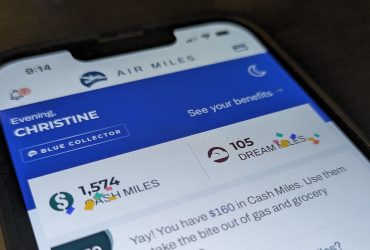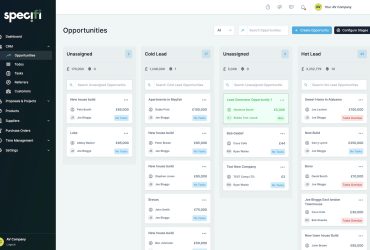The latest candidate in our series of Q&As with influential women in the technology business in Canada is Christina Wick, Senior Vice President, Product Experience at Vista, a marketing and design partner that works with millions of small businesses around the world.
Name: Christina Wick
Job Title: Senior Vice President, Product Experience, Vista
Years in the Industry: 23+ Years
The Quote That Most Inspires You: “Mom, you are both wrong. The glass is full. Half with water and half with air.” – This quote didn’t come from an author or philosopher, but from my son Christopher, who, at age 12, challenged me to think differently about problem-solving and leadership. I’ve taken my children to work, shared what I do, and workshop the day’s challenges at the dinner table. Because of this, Christopher’s wisdom reminded me that regardless of where you’re at on your journey, you always have something to teach, and, more importantly, something to learn.
What drew you to a career in tech?
Unlike most 16-year-olds, I knew that I wanted to be a manager when I grew up. That might sound like an unusual ambition, but even at a young age, I was fascinated by the idea of creating environments where people are constantly learning, taking pride in their work, and building great things.
My drive to become a manager came from various internships with the federal government, and at one role in particular, I had seen team members rejoice because a manager was leaving. I also watched as, one by one, team members resigned because a trusted, beloved manager had also departed. That correlation between leadership, belonging, and successful project outcomes guided me toward an education in computer science, something I knew I was good at. Because, if I wanted to manage software engineers, I knew had to be one first. And that, coupled with my interest in psychology, resulted in me concentrating in the field of human-computer interaction.
Multiple manager roles and two decades later, I’m thrilled to lead and empower my teams at Vista to create meaningful products and experiences for our customers.
Have you encountered any roadblocks along the way, specific to your gender?
I’ve been objectified because of my gender. I’ve experienced the real pay gap that exists between women and men. I’ve found myself in situations that were difficult to navigate and under circumstances that were hard to operate.
These roadblocks helped me recognize the importance of creating a support network of senior trusted leaders (men and women). Today, I have a handful of trusted leaders that I draw on for encouragement, advice, and diverse perspectives. I’ve also made it a priority to share my time with those who reach out to me – all you have to do is ask.
What unique perspective do you feel you bring to your organization as a woman?
The perspective I bring to Vista and to other organizations where I’ve worked is shaped by the pivotal moments I have experienced in my life. But to think about this question only as a woman feels limiting.
As a woman and a working mother, I’ve experienced gender bias. As an Asian, I’ve experienced racial bias. As a leader in technology and the only woman in a room full of men, I’ve felt out of place. How I’ve responded to and what I’ve learned from these situations are uniquely individual, but they’ve pushed me to implement changes that foster environments where everyone can thrive.
What do you think the tech industry needs to do to attract more women to leadership positions?
It’s difficult to break the glass ceiling when, in reality, the first rung of the ladder is broken.
According to a 2021 report from Accenture and Girls Who Code, 50 per cent of women who take a tech role will drop it by the age of 35, citing factors such as lack of advancement, higher rates of discrimination, and pay inequality.
What’s more, while women represent half the world’s population, women continue to be under-represented at leadership levels globally. Despite women’s historical and well-documented influence on our industry, gender bias remains a barrier. To attract more women to leadership positions, we need to bridge the pay gap and call out gender bias when we see it.
And, as a society, we must address this imbalance, alongside pipeline and retention challenges, with a focus on equal representation and parity. Let’s let both parents, parent. Let’s stop accepting less pay for the same work and redistribute the unpaid domestic and care work that often falls on women. Let’s foster more inclusive environments where all women can thrive.
Women in tech have long been innovators and the women who work alongside me at Vista continue to have an incredible impact on our business. I’m eager to see what else we can accomplish as we work hard to reverse this trend.

Technology is historically a male-dominated industry, yet the use of tech is fully embraced by women. What do you feel the technology industry needs in order to attract more women, particularly into high-level positions?
I often ask myself “why do I stay?” Being a woman in tech can be frustrating and exhausting, but I stay because I’m motivated to grow and develop the next generation of female tech leaders.
Two of my three children are female. Whether they pursue a career in technology or not, I want them all to feel confident knowing that their mom helped them enter a workforce that’s more equal and fairer than the one I joined.
What we need is equal representation of women and men at every level, and we need role models with which women can identify at these various levels. If I can pay it forward for my girls and help other women maximize their growth potential, there’s no end to the impact these women will have on technology and our future.
Are there any women in tech who inspire you?
I can always count on Joanna Lambert, my former manager at Venmo, to pick up the phone when I call. I’m inspired by the way she carries herself through challenging situations and the guidance she offers as I think about my own career. Not to mention, a sticker of her face on my laptop is a daily reminder of the strength of our connection and importance of community.
I am also grateful for the opportunity to work with Lea Hickman from the Silicon Valley Product Group. She is an amazing product leader and led one of the most impressive changes in a large company, Adobe, in our industry. Her vision, conviction, and success are truly inspiring.
Any misconceptions about being a woman in tech that you’d like to dispel?
I would like to dispel the misconception that technology is historically a male-dominated industry. Technology might be male dominated today, but women, historically, have been at the forefront. Ada Lovelace is widely regarded as the first computer programmer. Kathleen Antonelli and the five other women who worked with her on the Eniac developed and codified many of the fundamentals of computer science.
In fact, the percentage of tech workers who were women in 1984 (35%) is higher than it is today (32%), according to that same Accenture and Girls Who Code study; and the percentage of female computer science graduates in the mid-‘80s was significantly higher (37%) compared to the percentage of female computer science graduates today (18%).
I say this because it’s important to remember that, despite efforts to encourage more women to pursue technology careers, we’re trending backwards. As women in tech, it’s incumbent upon all of us to self-advocate and speak up. Collectively, our voices can influence a landscape where technology is designed and developed to represent what society really looks like.
What would you have done differently and why?
In 1998, I was offered to join a small start-up on the west coast that would require a cross-country move. This was early on in my career, and ultimately, the fear of making such a big move to a state in which I knew no one led me to pass on the job. To this day, I keep the T-shirt from that Google recruiting event hanging in my closet. It is the first thing I see in the morning and a constant reminder to not let fear hold me back – from anything.
Are you optimistic for the future?
My son was right when he said, “The glass is full,” even if half of it is filled with water and the other half is air. In this case, the latter half represents the reality of today’s regressive technology landscape. In order to thrive, technology needs women and the diverse, sometimes disruptive, perspective we bring to the table. Every time a woman elevates into a leadership role, questions the gender pay gap, or advocates for inclusivity, we add a new drop of water to that glass.
Although this change is incremental, I’m optimistic that all women in tech can move forward together and achieve parity.









